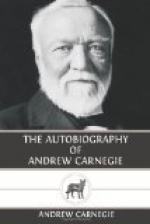CHAPTER X
THE IRON WORKS
The Keystone Works have always been my pet as being the parent of all the other works. But they had not been long in existence before the advantage of wrought- over cast-iron became manifest. Accordingly, to insure uniform quality, and also to make certain shapes which were not then to be obtained, we determined to embark in the manufacture of iron. My brother and I became interested with Thomas N. Miller, Henry Phipps, and Andrew Kloman in a small iron mill. Miller was the first to embark with Kloman and he brought Phipps in, lending him eight hundred dollars to buy a one-sixth interest, in November, 1861.
I must not fail to record that Mr. Miller was the pioneer of our iron manufacturing projects. We were all indebted to Tom, who still lives (July 20, 1911) and sheds upon us the sweetness and light of a most lovable nature, a friend who grows more precious as the years roll by. He has softened by age, and even his outbursts against theology as antagonistic to true religion are in his fine old age much less alarming. We are all prone to grow philosophic in age, and perhaps this is well. [In re-reading this—July 19, 1912—in our retreat upon the high moors at Aultnagar, I drop a tear for my bosom friend, dear Tom Miller, who died in Pittsburgh last winter. Mrs. Carnegie and I attended his funeral. Henceforth life lacks something, lacks much—my first partner in early years, my dearest friend in old age. May I go where he is, wherever that may be.]
Andrew Kloman had a small steel-hammer in Allegheny City. As a superintendent of the Pennsylvania Railroad I had found that he made the best axles. He was a great mechanic—one who had discovered, what was then unknown in Pittsburgh, that whatever was worth doing with machinery was worth doing well. His German mind made him thorough. What he constructed cost enormously, but when once started it did the work it was intended to do from year’s end to year’s end. In those early days it was a question with axles generally whether they would run any specified time or break. There was no analysis of material, no scientific treatment of it.
How much this German created! He was the first man to introduce the cold saw that cut cold iron the exact lengths. He invented upsetting machines to make bridge links, and also built the first “universal” mill in America. All these were erected at our works. When Captain Eads could not obtain the couplings for the St. Louis Bridge arches (the contractors failing to make them) and matters were at a standstill, Kloman told us that he could make them and why the others had failed. He succeeded in making them. Up to that date they were the largest semicircles that had ever been rolled. Our confidence in Mr. Kloman may be judged from the fact that when he said he could make them we unhesitatingly contracted to furnish them.




